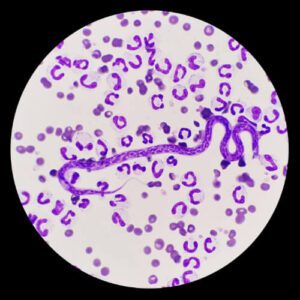National Heartworm Prevention Month

Happy National Heartworm Prevention Month!
I know, not as good as National Ice Cream month but important none the less. Heartworm is a life threatening disease which we have very good prevention and treatment options. It is heartbreaking to see a patient develop symptomatic heartworm disease knowing that the patient may have already suffered some permanent damage to this infestation. Be sure to check out American Heartworm Society’s Heartworm Incidence Maps.
What is Heartworm?
Heartworm is a parasite called Dirofilaria immitus. This parasite needs an intermediate host which is the mosquito. The following is the life cycle of the heartworm:
 The female mosquito takes in bloodmeal from the mammalian host and receives the first stage larvae.
The female mosquito takes in bloodmeal from the mammalian host and receives the first stage larvae.- The larvae mature within the female mosquito if temperatures are over 57 degrees.
- The mosquito then injects the 3rd stage larvae into a new mammalian host.
- These larvae mature over the next 2 – 12 days and migrate to the thorax.
- On day 50 – 70 the larvae reach their final maturity and are present in the thorax of the host.
- The 5th larval stage is present in the venous circulation and the pulmonary arteries. This is as early as 67 days after injection from the mosquito.
- Damage is dependent on the number of worms present
- At 120 days after initial infestation, the heartworms can reproduce in the host if there are more than 1 heartworm.
- Hosts are able to be infectious to other mammals at 6 – 9 months after initial injection of the 3rd stage larval
What happens to the dog infested with Heartworm?
The adult heartworms live in the pulmonary arteries and other large vessels of the thorax. They cause damage to the arteries themselves and eventually the lungs and smaller vessels. This can lead to pulmonary hypertension, thromboembolism and cardiac hypertrophy. These changes do take months before detection and luckily 32% of dogs that are diagnosed are asymptomatic.
Another bacteria is often associated with heartworm called Wolbachia. This works in conjunction to help the heartworm survive and causes inflammation for the host. If we find heartworm, we also treat for Wolbachia with antibiotics.
As the infestation causes more damage, other organs will be affected. This includes the liver and kidneys. These worms cause red blood cell damage and the caudal vena cava (the large vein in the abdomen) to be nonfunctional and cause acute shock.
What signs should I look for?
If you believe your dog may have picked up heartworm some signs to watch for include:
- Weight loss
- Exercise intolerance
- Cough
- Rapid breathing
- Respiratory distress
- Fever
- Lethargy
How to test for heartworm?
Testing is the best way to detect heartworm early before signs have developed. A simple bloodtest is ran at your veterinary clinic which takes only a few minutes. Remember there is an incubation period so if you test today, remember to test next year to make sure you didn’t miss the heartworm that was developing in your dog.
How to treat heartworm?
Treatments have advanced since my childhood dog had heartworm in the 1970’s. At that time, small doses of arsenic were administered. This was very dangerous and many dogs did not survive. Today, the medication is also an arsenic compound and carries with it risks but much less than the original treatment. Luckily, my sweet pup lived a very long life after her heartworm treatment as is often the case today.
Today, patients are staged to determine how severely their bodies have been affected by the heartworm. Precautions are taken to attempt to avoid complications from the killing off of the worms themselves.
At the time of treatment, the patient can have 3 types of heartworm adult heartworms, microfilariae which can be picked up by mosquitos and Larvae which will grow into new heartworm adults. We need to treat all of these life stages.
During treatment, patients can get quite ill. It is important to keep your veterinarian informed of any symptoms such as coughing, bleeding or fever. The most critical time is day 7 – 10 after adulticide treatment.
How can I prevent my dog from getting Heartworm?
As you can see, prevention is so important. These silent killers can go undetected for years until the damage is irreversible. In our area, wild populations of fox and coyotes can be carriers of Heartworm. The fox population in more urban areas is growing. If your dog is exposed to mosquitos, they can get heartworm disease. If one dose is missed or delayed, your pet can get heartworm infestation.
Options for prevention are very abundant. We carry several in the clinic and other options are available on our online pharmacy.
Heartgard Plus – in clinic
Nexgard Plus – in clinic
Revolution Plus-in clinic
Simparico trio – online pharmacy
Intereptor – online pharmacy.
A note about seizures associated with heartworm prevention –Nexgard Plus and Simparico have cautions about use in seizing dogs. However, this seems to be more associated with flea and tick components rather than the heartworm medication.
Heartworm testing should be started when your puppy is over 7 months of age at the latest and should be repeated yearly.
If you have any questions about heartworm disease our technicians and veterinarians are here to answer any additional questions you may have. Just give us a call at (515) 292-0400 .
About Us
We are a woman-owned practice committed to making you and your pet feel at home in our Ames, IA animal hospital. We deliver a full range of services to nurture their health and give them as many years as possible with you. Our services range from life stage wellness care and prevention to surgery, dentistry, and internal medicine, with the goal of meeting all your companion’s needs for life.
